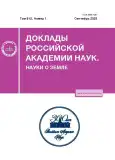TO A QUESTION OF SULFUR SITES IN CRYSTAL STRUCTURES OF TETRAHEDRITE GROUP MINERALS: RELATIONSHIPS BETWEEN OCCUPANCY, EFFECTIVE ION SIZES, AND UNIT CELL PARAMETERS
- Authors: Lyubimtseva N.G.1, Marchenko E.I.2, Eremin N.N.2, Bortnikov N.S.1
-
Affiliations:
- Institute of Geology of Ore Deposits, Petrography, Mineralogy, and Geochemistry, Russian Academy of Sciences
- Lomonosov Moscow State University
- Issue: Vol 512, No 1 (2023)
- Pages: 66-71
- Section: MINERALOGY
- Submitted: 14.10.2023
- Published: 01.09.2023
- URL: https://journals.rcsi.science/2686-7397/article/view/135888
- DOI: https://doi.org/10.31857/S2686739723601138
- EDN: https://elibrary.ru/IRUFBH
- ID: 135888
Cite item
Full Text
Abstract
In this work, a crystal chemical analysis of the known experimentally deciphered crystal structures of tetrahedrite group minerals was carried out in order to reveal the relationships between the occupancies of anion crystallographic sites in the structures, their effective sizes and unit cell parameters. To achieve this aim, we analyzed the effective sizes of the 24g and 2a anion sites in 68 deciphered crystal structures of tetrahedrite group minerals according to the published data. The analysis was carried out using the TOPOSPro software package by partitioning the space into Voronoi–Dirichlet polyhedra (VDP). It has been shown theoretically for the first time that the content of a large sulfur ion and its deficiency affect the unit cell parameter. A linear correlation between the VDP volume of the anionic site of S2– (24g) and the unit cell parameter in minerals of the tetrahedrite group was established, which shows that the anionic substructure dictates the structural motif in this class of compounds. It was found that the change in the VDP volumes of sulfur anions is associated with different occupancies of anionic sites. It is found that the formula (unit cell) of the compound contains fewer than 13 sulfur ions in almost all deciphered crystal structures of tetrahedrite group minerals. It was concluded that the calculated VDP volume of the 24g anionic position less than 22 Å3 indicates a significant deficit in the anionic substructure. It was shown that, using information about the VDP volumes of all anionic and cationic sites in the structure, it is possible to predict the unit cell parameters of minerals of the tetrahedrite group with an accuracy of 0.01 Å
About the authors
N. G. Lyubimtseva
Institute of Geology of Ore Deposits, Petrography, Mineralogy, and Geochemistry, Russian Academy of Sciences
Author for correspondence.
Email: luy-natalia@yandex.ru
Russian Federation,
Moscow
E. I. Marchenko
Lomonosov Moscow State University
Email: luy-natalia@yandex.ru
Russian Federation, Moscow
N. N. Eremin
Lomonosov Moscow State University
Email: luy-natalia@yandex.ru
Russian Federation, Moscow
N. S. Bortnikov
Institute of Geology of Ore Deposits, Petrography, Mineralogy, and Geochemistry, Russian Academy of Sciences
Email: luy-natalia@yandex.ru
Russian Federation,
Moscow
References
- Biagioni C., George L.L., Cook N.J., Makovicky E., Moëlo Y., Pasero M., Sejkora J., Stanley C.J., Welch M.D., Bosi F. The tetrahedrite group: Nomenclature and classification // American Mineralogist. 2020. V. 105. № 1. P. 109–122. https://doi.org/10.2138/am-2020-7128
- Мозгова Н.Н., Цепин А.И. Блеклые руды. (Особенности химического состава и свойств). Москва: Наука, 1983.
- Любимцева Н.Г., Бортников Н.С., Борисовский С.Е., Прокофьев В.Ю., Викентьева О.В. Блеклая руда и сфалерит золоторудного месторождения Дарасун (Восточное Забайкалье, Россия). Часть 1: Минеральные ассоциации и срастания, химический состав и его эволюция // Геология рудных месторождений. 2018. Т. 60. № 2. С. 109–140. https://doi.org/10.7868/S0016777018020016
- Tatsuka K., Morimoto N. Tetrahedrite stability relations in the Cu–Fe–Sb–S system // American Mineralogist. 1977. V. 62. № 11–12. P. 1101–1109.
- Бортников Н.С., Некрасов И.Я. Состав и фазовые взаимоотношения теннантита в системе Cu–Fe–As–S при 500°С // Доклады АН СССР. 1987. Т. 297. № 2. С. 449–451.
- Luce F.D., Tuttle C.L., Skinner B.J. Studies of sulfosalts of copper: V. Phases and phase relations in the system Cu–Sb–As–S between 350° and 500°C // Economic Geology. 1977. V. 72. № 2. P. 271–289. https://doi.org/10.2113/gsecongeo.72.2.271
- Белов Н.В., Победимская Е.А. Очерки по структурной минералогии. XXIV. Повторно о некоторых сульфидах и их аналогах // Минералогический сборник Львовского государственного университета им. И. Франко. 1973. Выпуск 1. № 27. С. 3–9.
- Welch M.D., Stanley C.J., Spratt J., Mills S.J. Rozhdestvenskayaite Ag10Zn2Sb4S13 and argentotetrahedrite Ag6Cu4(Fe2+, Zn)2Sb4S13: two Ag-dominant members of the tetrahedrite group // European Journal of Mineralogy. 2018. V. 30. № 6. P. 1163–1172. https://doi.org/10.1127/ejm/2018/0030-2773
- Biagioni C., Sejkora J., Moëlo Y., Makovicky E., Pasero M., Dolníček Z. Kenoargentotennantite-(Fe), IMA 2020-062. In: CNMNC Newsletter № 58 // Mineralogical Magazine. 2020. V. 84. P. 971–975. https://doi.org/10.1180/mgm.2020.93
- Qu K., Sima X., Gu X., Sun W., Fan G., Hou Z., Ni P., Wang D., Yang Z., Wang Y. Kenoargentotetrahedrite-(Zn), IMA 2020-075. In: CNMNC Newsletter № 59 // Mineralogical Magazine. 2021. V. 85. P. 278–281. https://doi.org/10.1180/mgm.2021.5
- Shu Z., Shen C., Lu A., Gu X. Chemical Composition and Crystal Structure of Kenoargentotetrahedrite-(Fe), Ag6Cu4Fe2Sb4S12, from the Bajiazi Pb–Zn Deposit, Liaoning, China // Crystals. 2022. V. 12. № 4. P. 467. https://doi.org/10.3390/cryst12040467
- Sack R.O., Lyubimtseva N.G., Bortnikov N.S., Anikina E.Y., Borisovsky S.E. Sulfur vacancies in fahlores from the Ag–Pb–Zn Mangazeyskoye ore deposit (Sakha, Russia) // Contributions to Mineralogy and Petrology. 2022. V. 177. № 8. P. 82. https://doi.org/10.1007/s00410-022-01942-5
- Rozhdestvenskaya I.V., Zayakina N.V., Samusikov V.P. Crystal structure features of minerals from a series of tetrahedrite-freibergite // Mineralogiceskij Zhurnal. 1993. V. 15. P. 9.
- Blatov V.A., Shevchenko A.P., Proserpio D.M. Applied topological analysis of crystal structures with the program package topospro // Cryst. Growth Des. American Chemical Society. 2014. V. 14. № 7. P. 3576–3586. https://doi.org/10.1021/cg500498k
Supplementary files












